Adventure – Coot's Reviews (original) (raw)
Tag Archives: Adventure
March 8, 2024 · 12:01 am
The Future by Naomi Alderman

The road to ruin is paved with certainty. The end of the world is only ever hastened by those who think they will be able to protect their own from the coming storm.
Love is the mind killer.
So what would you do if your super-secret software gave you the alert? End times are afoot. Time to scoot! If you are like most of us, you might seek our your nearest and dearest to see the world out together. But what if you are one of the richest people on the planet? Well, in that case, you would have prepared a plan, an escape, a plane, supplies, a bunker somewhere safe. Buh-bye, and off they go. The they in this case includes three billionaires, the heads of humongous tech companies, some years in the not-too-distant future, Lenk Sketlish, Zimri Nommik, and Ellen Bywater.
They were definitely not inspired by anyone specifically who could sue me for everything I’m worth and barely notice it…They are composite characters made up of some of the ridiculous and awful things that tech billionaires have done and some of it just made up out of my head. But of course the companies are inspired by real companies. – from the LitHub interview
What if you were the number one assistant to one of these folks, or the less-than-thrilled wife of another, or the ousted former CEO and founder of a third one, maybe the gifted child of one? You might have been spending your time trying to see what you could do to mitigate the vast harm these mega-corporations have done to the planet. These are Martha Einkorn, Lenk’s #2, Selah Nommik, Zimri’s Black British wife, Alex Dabrowski, founder and former CEO of the company now headed by Ellen, and Badger, Ellen’s son.
“Margaret [Atwood] has very much covered how bad it can get, so we don’t need a lesser writer doing that,” Alderman says. “I’m interested in the most radical ideas about how we can make things better, and what are the avenues we can pursue.” – from the AP interview
BTW, Atwood mentored Alderman.
What if you were attending a conference in Singapore, having recently met one of group B above for an interview, and gotten entangled in an unexpected way, but now find yourself in the vast mall in which the conference is being held, being chased and shot at by some psycho, probably a religious nut? Lai Zhen is a 33yo refugee from Hong Kong, an archaeologist and well-known survivalist influencer. She had met someone she thinks may be The One, but her immediate survival is taking up all available mental space. Thankfully, she has help, but will it be enough?

Naomi Alderman – image from The Guardian
The action-adventure-sci-fi shell encasing The Future is a dystopian near-future that takes an if-this-goes-on perspective re the road we are currently traveling toward planetary devastation, global warming, the increasing greedification of the world economy, and concentration of wealth, at the expense of sustainability and human decency. But Alderman has done so much more with it.
The Future has a brain and a heart, to go along with the coursing hormones, and some serious mysteries as well. Did I mention there is a romance in here also? Good luck shelving this thing. You probably will not have much luck putting it down once you start reading. Well, take that advisedly. I did find that it took a while to settle in, as there is a fair bit to get through with introducing all the characters, but once you get going, day-um, you will want to keep on.
While offering a look at survival post everything, Alderman tosses in some fun high tech and BP-raising sequences. And she gives readers’ brains a workout, providing considerable fodder for book club discussions. To bolster the thematic elements, Aldermen provides plenty of connections to classic tales, biblical and other, that offer excellent starting points for lively discussions.
Martha was raised in an apocalypse-concerned cult, led by her father. As an adult she gets involved in on-line exchanges about questions like what might be learned from the experience of a biblical apocalypse survivor, Lot. Alderman was raised as an Orthodox Jew, studying the Torah in the original, so knows her material well. (God was about to firebomb Sodom when Lot’s kindness to a couple of god’s emissaries earned him and his family a get-out-of-hell-free pass.) In addition, she finds relevance in Ayn Rand, The Iliad, The Odyssey, and more.
She brings in a discussion of the enclosure act in the UK, how the stealing of public land by the wealthy has a mirror in the theft of public space of different sorts in the 20th and 21st centuries. But the biggest issue at work here is trust. In fact, Alderman had intended to title the book Trust. But when Herman Diaz’s novel, Trust, won a Pulitzer Prize, she had to find an alternative. Can Zhen trust her new love interest. Can she trust the AI that is supposedly helping her? Can she trust any of the oligarchs? Can she trust people she has known for years on line, but never met in person? This is a core concept, not just on a personal, but on a societal level. Civilizations are built on trust. It is an issue that touches everyone.
The wealthier you are, the less you have to ask people things and the less you ask people for things, the less you have to discover that you can trust and rely on them. Eventually, that erodes your ability to trust. Then, you’re sunk. – from the Electric Literature interview
Consider a concern that is immediate in early 2024. Can American allies, whose alliances have kept the world out of World War III since the end of World War II, trust the US intelligence services with their secrets, when our next president might give, trade, or sell it to our enemies? Can you trust that the person you are communicating with on-line is being honest with you. (As someone who has met people through Match.com, I am particularly aware of that one.) If you are stuck on a survival island, can you trust that the other people there will not do you in, in order to improve their chances of gaining power once things begin to return to some semblance of global livability?
In today’s culture, technology, particularly social media, “encourages us not to really trust each other,” Alderman explains. “The ways that we use to communicate with each other have been monetized in order to make us as angry at and afraid [of one another] as possible.” And while the internet can all too often amplify “absolute hateful stupidity” to feed our distrust of one another, the author continues, “It can also demonstrably, again and again, multiply our knowledge and capacity to understand.” – from the Shondaland interview
Zhen’s is our primary POV through this, although we spend a lot of time with Martha. She is an appealing lead, a person of good intentions, and reasonably pure heart. She is wicked smart, able, and adaptive. It is easy to root for her to make it through. But, noting the second quote at the top of this review, if Love is the mind killer, might it impair her clarity of thought, her maintenance of necessary defenses? Of might it impair that of the person she is love with?
The concern with dark forces is a bit boilerplate. Two of the oligarchs are cardboard villains; another has some edges.
But it is the conceptual bits that give The Future its heft. Oh, and one more thing. Woven throughout the 432 pages of this book is minor crime, Grand Theft Planet. It should come as no surprise that an author who has had great success with her previous novels, and who has spent some years writing video games, would produce a fast-paced, engaging read, replete with dangers, anxieties, fun toys, and wonderful, substantive philosophical sparks. I cannot predict the future any better than 2016 presidential pollsters, but my personal AI suggests that should The Future will find its way to you, you will be glad it did.
Imagining bad futures creates fear and fear creates bad futures. The pulse beats faster, the pressure rises, the voice of instinct drives out reason and education. At a certain point, things become inevitable.
Review posted – 3/8/24
Publication date – 11/7/23
I received an ARE of The Future from Simon & Schuster in return for a fair review, and the password to my super-secret software. Thanks, folks, and thanks to NetGalley for facilitating.
This review is cross-posted on Goodreads Goodreads. Stop by and say Hi!
=======================================EXTRA STUFF
Links to the author’s personal, Instagram, GR, and Twitter pages
Profile – from Simon & Schuster
Naomi Alderman is the bestselling author of The Power, which won the Women’s Prize for Fiction, and was chosen as a book of the year by The New York Times, The Washington Post, the Los Angeles Times, and was recommended as a book of the year by both Barack Obama and Bill Gates. As a novelist, Alderman has been mentored by Margaret Atwood via the Rolex Arts Initiative, she is a Fellow of the Royal Society of Literature, and her work has been translated into more than thirty-five languages. As a video games designer, she was lead writer on the groundbreaking alternate reality game Perplex City, and is cocreator of the award-winning smartphone exercise adventure game Zombies, Run!, which has more than 10 million players. She is professor of creative writing at Bath Spa University. She lives in London.
Interviews
—–Professional Book Nerds – Dystopian Futures with Naomi Alderman – video, well, mostly audio, with no real video – 41:59
—–Toronto Public Library – Naomi Alderman | The Future | Nov 13, 2023 with Vass Bednar – 45:05 – there is a nice bit in here on tech as neither bad nor good, but a tool which can be used for good or evil.
—–Literary Hub – Naomi Alderman on Creating a Fictional Tech Dystopia by Jane Ciabattari
—–Shondaland – Naomi Alderman Is Still Finding Hope in Humankind by Rachel Simon
—–AP- Naomi Alderman novel ‘The Future’ scheduled for next fall by Hillel Italic
—–Electric Literature – Dystopian Future Controlled by Technology by Jacqueline Alnes
—–Independent – How We Met: Naomi Alderman & Margaret Atwood – by Adam Jacques – Atwood mentored Alderman in 2012 – a fun read
Item of Interest from the author
—–BBC Sounds – audio excerpt – 1.0 – The End of Days – 15:47
Items of Interest
—–Tristia by Ovid – Zhen reads this prior to a trip to Canada
—–The Admiralty Islands
—–inert submunition dispenser – a kind of cluster bomb
—–Wiki on the enclosure act
Filed under Action-Adventure, AI, Cli-Fi, computers, Fiction, Literary Fiction, Mystery, Reviews, Science Fiction, Thriller, Thriller
Tagged as Adventure, apocalypse, book-review, book-reviews, books, brain-candy, computers-ai, crime, Fiction, literary-fiction, Science Fiction, science-fiction, Thriller
October 6, 2023 · 12:01 am
First to the Front by Larissa Rinehart

On Sunday February 18, [1945] the lieutenant in charge of Navy press at the Oakland air base agreed to see her. Eying her credentials once more, he handed them back. “And just where was it you wanted to go,” he asked. She had been rehearsing her response ever since her credentials first arrived in the mail. “As far forward as you’ll let me,” she replied. “Be here at 0600, tomorrow,” he said.
…good intentions have rarely paved such a direct route to hell.
Back in World War II there was a small bit of graffiti that appeared in many places across the world. It showed a nose, the fingers of two hands and eyes peeking over a wall, or a fence, along with the words “Kilroy was here.” It was meant to show that American soldiers had been in a particular place, and that they had been everywhere. If Dickey Chapelle had wanted to, she could have left her graffiti across the world as well, not just to show that she had been there, but that she had been the first woman, the first reporter, the first woman reporter who had done the job in many, many dangerous places.
She slept in Bedouin tents in the Algerian desert, and in the foxholes she dug herself in the hills overlooking Beirut. She rode in picket boats between battleships off the coast of Iwo Jima and flew in a nuclear-armed jet stationed on an aircraft carrier in the Aegean sea. On New Year’s Eve 1958, she patrolled the Soviet border with the Turkish infantry. On New Year’s Day 1959, she photographed Fidel Castro’s army as they entered Havana. She jumped out of planes over America, the Dominican Republic, South Korea, Laos, and Vietnam. She heard bullets flying over her head in Asia, North America, Europe, and Africa, and knew that they all sounded the same.
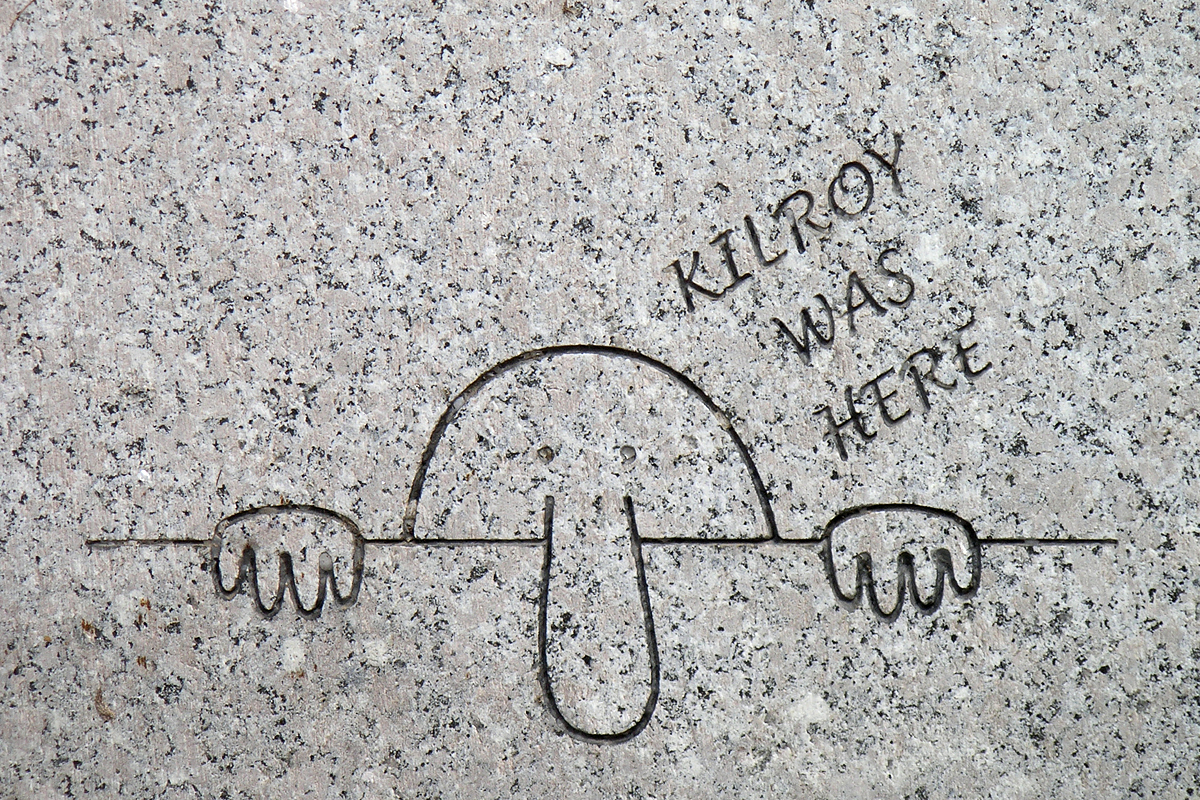
Engraving of Kilroy on the National World War II Memorial in Washington D.C. – image and descriptive text from Wikipedia
It is likely you have heard of Margaret Bourke-White, famed for her coverage of World War II. You may have heard of Marguerite Higgins, noted for reporting on the Korean War. It is very unlikely you have heard of the subject of this book. Go on Wikipedia, or most other places that aggregate such information, and look up World War II correspondents. Chapelle, whose full name was Georgette Louise Marie Meyer Chapelle, is unlikely to appear. Yet, she did seminal work covering diverse elements of the war, including battles on the front lines. She even trained as a paratrooper, so she could jump into battle zones with American military units, which she did. Lorissa Rinehart seeks to correct that oversight.

Lorissa Rinehart – Image from Macmillan
She tracks Dickey from her brief stint as a student of aeronautical engineering at MIT. Soon after, she was a journalist in Florida, covering a tragic air show in Cuba. It was her first real reporting “at the front” of a deadly event. And the way ahead was set. When Hitler invaded Poland in 1939, she saw that war was coming with United States. Although Congress did not agree to declare war, it did ramp up production of airplanes and other war materials to support the effort against Nazism.
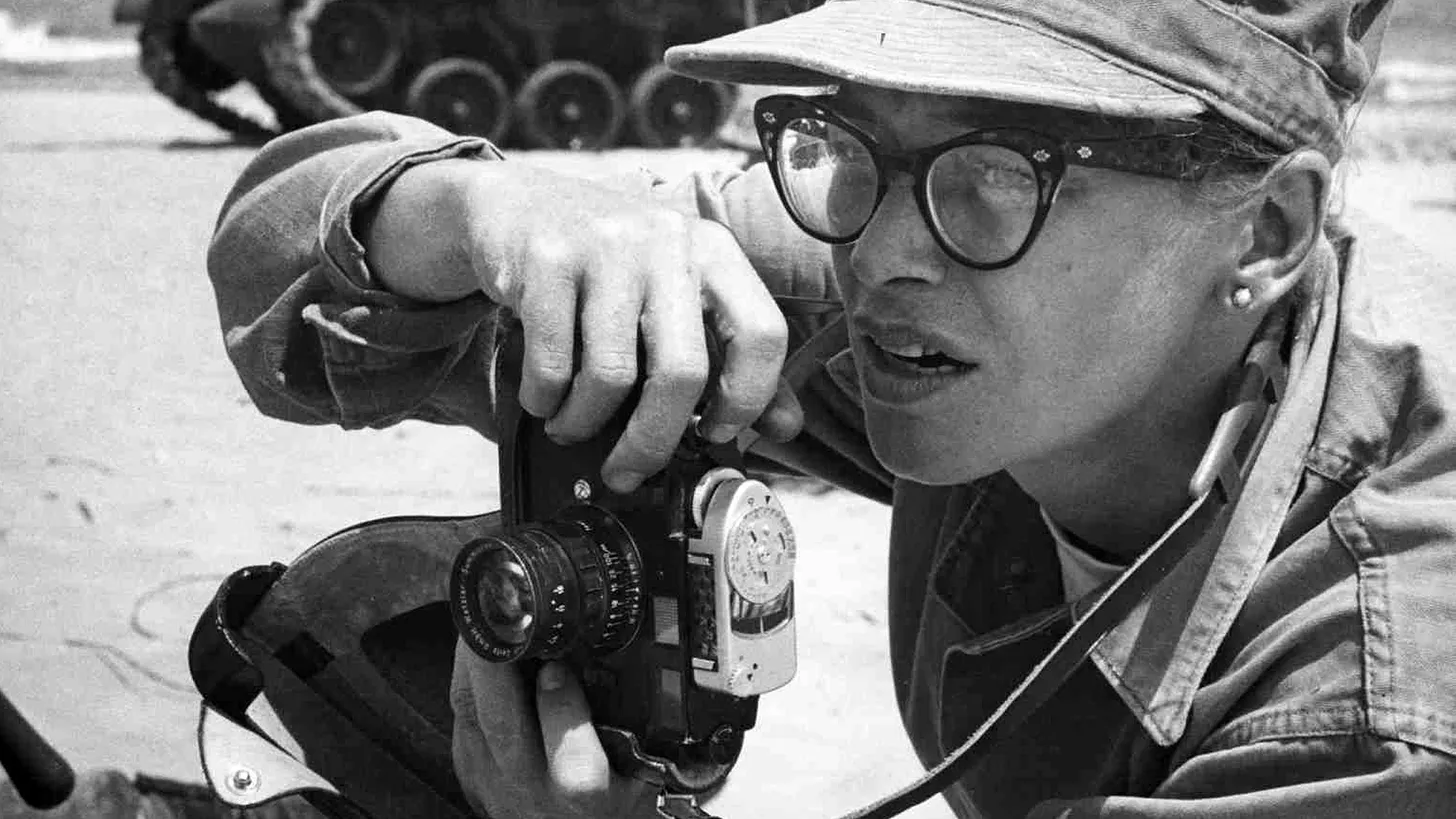
Dickey Chapelle – Image from Narratively, courtesy of Wisconsin Historical Society
She learned that she would have to become a photographer if she wanted to cover the war. So she took photography classes. Among her teachers was the man she would marry, Anthony “Tony” Chapelle. Their relationship was never a natural. He was much older, controlling, with a temper, described by some as a consummate con man. He would be jealous of her successes, and seemingly always eager to undermine her confidence. But he was a very successful war photographer and taught her the skills that would enhance her natural eye, helping make her the great photojournalist she would become.
Dickey Chapelle photographs marines in 1955 – image From Wall Street Journal – from Wisconsin Historical Society
Rinehart tracks not only Chapelle’s adventures on the front lines of many military conflicts, but the skirmishes in which she was forced to engage to gain permission to be there at all. Sexism, as one would expect, forms a major portion of those struggles, but some had to do with her being a journalist at all, regardless of her gender. There is a string of firsts next to her name in the history of journalism, and the word “female” does not appear in all of them. Sadly, she was the first female correspondent killed in Viet Nam.

Chapelle with Pilots – image from the Wisconsin Historical Society
Dickey was tough as nails, enduring some of the same training as the GIs she was covering. In addition to her considerable coverage of World War II, she was on the front lines of the major hot spots in the Cold War. Not only embedded with marines, Chapelle spent considerable time with troops from Turkey, Castro’s rebels in Cuba, anti-Castro plotters in Florida, secret American forces in Laos, Laotian anti-communist fighters, Algerian revolutionaries, Hungarian rebels, and more. The list is substantial. She would keep diving in, wanting to get the immediate experience of the fighters, the civilians caught in the crossfire, the human impact of war. No Five o’clock Follies for Dickey. She was not interested in being a stenographer for brass talking points, seeing that approach as the enemy of truthful reporting.
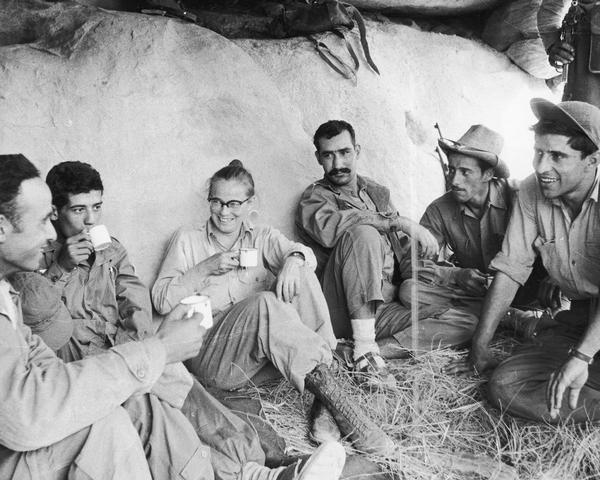
Dickey Chapelle sits and drinks coffee with the FLN Scorpion Battalion Rebels in the Atlas Mountains in Algeria
– image and descriptive text from the Wisconsin Historical Society – shot by Dickey Chapelle
Chapelle was captured, imprisoned, and tortured in Hungary by Soviet forces. It gave her a particularly pointed perspective on the treatment of prisoners by Western militaries, and the greater implications of the USA not holding to the highest international standards.
One of her greatest gifts was a respect for local cultures and particularly local fighters. She was quite aware of how hard they trained, how hard and far they pushed themselves, how much deprivation they willingly endured. Yet she encountered attitudes from American officers and leaders that regarded non-white fighters through a self-defeating racist lens. Chapelle tried to get the message across to those in command how wrong they were in their regard for the locals the USA was supposedly there to support. Despite occasionally breaking through the brain-truth barrier, that engagement proved a demoralizing, losing battle.

Iwo Jima Medical Facilities – image from the Wisconsin Historical Society – shot by Dickey Chapelle
Another example of her analytical capability was fed by her time with a community in Laos, led by a cleric, possessed of superior tactical and political approaches. She tried to bring her knowledge of this to American military leaders. It was not a total failure. Although her ideas were not implemented to a meaningful extent, she was eventually brought in by the military to teach what she knew to new officers.
Through much of her work, which included extensive coverage of the on-the-ground Marshall Plan in Europe, her marriage to Tony was seemingly in constant crisis. It was an ongoing war, with dustups aplenty, advances and retreats, damage incurred, but resulted, ultimately, in a separation of forces, which freed Chapelle to pursue her front-line compulsion unimpeded by contrary wishes.
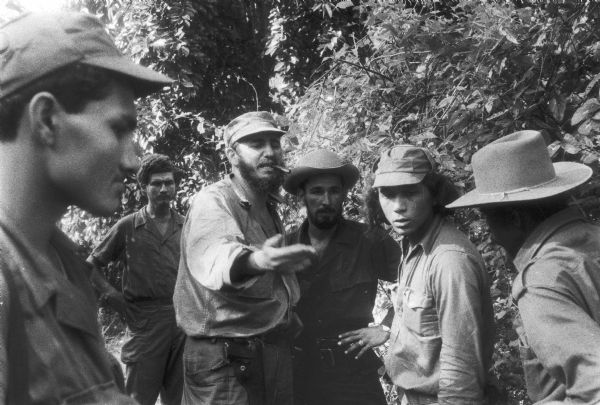
Fidel Castro with cigar, and five other men
– image from the Wisconsin Historical Society – shot by Dickey Chapelle
Her employers were not always news outlets. She was employed by the Red Cross to document the need for blood in the war zone. She covered a hospital ship, and medical units on the battlefield. It was hoped that her coverage would give a boost to a national blood drive encouraging Americans to give blood for wounded soldiers. It was a huge success. She worked for the American Friends Service Committee covering military behavior in the Dominican Republic. Other non-profits paid for her to report from other parts of the world. And sundry magazines provided enough employment to keep her working almost constantly.

A woman in a headscarf crosses an improvised bridge in the vicinity of the village of Tamsweg, escaping from Hungary to Austria
– image from the Wisconsin Historical Society – shot by Dickey Chapelle
This is an amazing book about an amazing woman.The story of Dickey Chapelle reads like fiction. Even though we know this is a biography, and that what is on the page has already occurred, Rinehart makes the story sing. Her story-telling skill brings us into the scenes of conflict, sometimes terror, so we tremble or gird along with her subject. She taps into the adventure of Dickey’s life, as well as the peril. This is the life that Dickey had sought, and which would be her undoing. The book reads like a novel, fast, exciting, eye-opening, frustrating, enraging, sad, but ultimately satisfying. Dickey Chapelle’s was a life that was as rich with stumbling blocks as it was with jobs well done, but ultimately it was a life well lived, offering concrete benefits to those who were exposed to her work, and an inspiration for many who have followed in her bootsteps.
I side with prisoners against guards, enlisted men against officers, weakness against power.
—Dickey Chapelle
Review posted – 10/6/23
Publication date – 7/11/23
I received a copy of First to the Front from St. Martin’s Press in return for a fair review. Thanks, folks.
This review is cross-posted on Goodreads. Stop by and say Hi!
======================================EXTRA STUFF
Links to Lorissa Rinehart’s personal, FB, and Instagram pages
Profile – from Women Also Know History
Lorissa Rinehart writes about art, war, and their points of intersection.
Her writing has recently appeared in Hyperallergic, Perfect Strangers, and Narratively, among other publications…When not writing she can be found photographing the natural world impinging upon the urban landscape or digging in the dirt with her husband and two sons in Santa Barbara, California. She holds an MA from NYU in Experimental Humanities and a BA in Literature from UC Santa Cruz.
Interviews
—–Writers Talking – Season 2 Episode 7 – Talking to Lorissa Rinehart – podcast – 50:30
—–Hidden History Podcast – A Conversation with Lorissa Rinehart with John Rodriguez – video – 40:18 – begin at 1:43 – there is a transcript on the side
—–Cold War Conversations – Dickey Chapelle – Trailblazing Female Cold War Journalist – audio – 1:01:50
Items of Interest from the author
—–The War Horse – excerpt
—–Facebook reel – Rinehart on Dickey Chapelle showing incredible guts
—–FB – The Top 10 Books She Read to Prepare
—–The History Reader – Escaping Algeria – excerpt
—–Narratively – The Parachuting Female Photojournalist Who Dove Into War Headfirst
Item of Interest
—–Milwaukee PBS – Behind the Pearl Earrings: The Story of Dickey Chapelle, Combat Photojournalist – video documentary- 56:05
—–Political Dictionary – Five o’clock Follies
#womeninwwii #womeninwar #womenjournalists #womenheroes #wwiibooks #wwiihistory #newbooks #mustread
Filed under American history, Bio/Autobio/Memoir, biography, Feminism, History, Journalism, Non-fiction, Public policy, Reviews, World History
Tagged as 2023-nonfiction-reader-challenge, Adventure, american-history, biography, books-of-the-year-2023, feminist, history, military-and-intelligence-non-fic, Nonfiction, public-policy, world-history-non-fiction, world-war-ii
May 12, 2023 · 12:01 am
Fairy Tale by Stephen King

I’d heard of curses—the storybooks are full of them—but this was the first time I’d seen one in action.
You never know where the trapdoors are in your life, do you?
Once Upon a Time, Stephen King decided to write a fairy tale. So, bring in some Brothers Grimm, Disney, Mother Goose, add in some H.P. Lovecraft, for good measure, and plenty more, stir for a good long while in the cauldron that is SKs brain, and “Poof!” There it appears. Being Stephen King, the book is over 600 pages, so not exactly Mother Goose length.
I love all the stuff that Robert E. Howard, Conan the Barbarian and some of the characters in the Edgar Rice Burroughs books, who would find these strange deserted cities, monsters and things. I thought it’s kinda like fairy tales. And I started to kinda get interested in that, and I thought maybe I could combine those two things, Maybe I could take the whole fairy tale riff. – from the Losers Club interview
Charlie Reade is a pretty good kid. But he hit into a bit of bad luck. He was seven when Mom made the mistake of walking across a local bridge on an icy night. Soon after, dad started drinking in earnest, managed to survive in his job for three years, but was ultimately let go. After months of ever worse drinking by his dad, Charlie did something that was alien to him.

Stephen King – image from The Financial Times
He prayed to God to help his dad. Help arrives when Charlie is ten in the form of a former workmate introducing pop to AA. Feeling that he must hold up his end of the deal, Charlie is ever on the lookout for the task that he thinks God wants him to take care of. Years later the day arrives, and Charlie, seventeen now, steps up, saving the life of a local crank who had had a bad accident. Mr. Bowditch had more than just a foul temper and a creepy old house. He had an old German Shepherd, Radar, who loved him dearly. Charlie takes on the task of caretaking Radar and Mr. Bowditch, and fast friendships develop. Bowditch had another thing of some significance, a shed covering the entrance to a hidden world.

Mr. Bowditch’s house is referred to as “The Psycho House” by the locals – from the book
There comes a time (about 35% of the way in) when it is necessary for Charlie to brave that journey and the story takes off, as Charlie and Radar head down and out of this world. There is a sundial down there that can reverse-age the now-beloved dog. Charlie is determined to save her.
…these books, particularly the Edgar Rice Burroughs books, like John Carter of Mars…they’re supposed to have this hero who’s like, muscular, you know, he played football in college and at the same time he’s got a brain, he’s handsome and got a cleft chin and all that good stuff and I thought I’d like to write a character like that. I’d like to write a character, who’s big, tough, tall, strong, who’s smart, but I want to give him a dose of reality. If he’s a kid, a younger man, who as a younger kid put dogshit on a bad teacher’s windshield, and glued somebody’s ignition shut. In other words I wanted him to have an anti-Disney kind of thing in there. – from the Losers Club interview
King succeeds in giving Charlie some dark sides, but he also gives him a large dose of shame to balance it out.
Fairy Tale follows the familiar Campbellian structure of the Hero’s Journey monomyth, in which a “hero” goes on an adventure, leaving our pedestrian plane to take on challenges in a supernatural world, usually one below ours, engages in victorious battle, and returns home wiser and more powerful than when he or she left, with a newly enhanced ability to help others.
Once down below, in a world called Empis, Charlie encounters many characters who would be quite comfortable in traditional western fairy tales. It is a magical place, as one might expect. There are multiple dealings with Rumpelstiltskin-type characters, (names figure very large here) royalty disguised as commoners, sentient non-human life, (including a cricket who might remind one of another boy on a journey) and a general bleakness darkening the land. I was reminded of C.S. Lewis’s Narnia series opener, in which that troubled land was described as being “Always winter but never Christmas.” More immediate correlations might be to King’s own The Talisman, The Dark Tower, and From a Buick 8, Rose Madder, and Lisey’s Story, which all feature cross-world portals.
Charlie must face and overcome perils in this new (to him) world, in order to achieve his goal of saving Radar. But, Charlie is somehow seen by the locals as some sort of a savior, a prince. (which again reminded me of Peter in Narnia) Charlie finds this odd (who, me?) but also feels a need to help out, so does what he can. Adventure ensues, as does a relentless, and very fun series of references to fairy tales of diverse sorts. King finds his fairy tales in various places. TCM flicks are among them, Niietzsche, Dickens, Kipling, Mark Twain and Thackery, Ray Bradbury, Jung, Lovecraft, Game of Thrones, Piers Anthony, and others.
I tried to put in every goddam fairy tale I could think, including Ariel, the mermaid from the Disney film. – from the Losers Club interview
The Wizard of Oz is a particular favorite, as there are multiple references, including an emerald city, fields of poppies, and a bit on the importance of shoes.

Radar and Charlie – from the book
The overall structure of the novel is a frame. Chapter one is Charlie telling us that he is going to tell us a tale–so we know that he will survive–and ends with Charlie letting us know that he is a twenty-something teacher of a seminar on Myth and Fairy Tales. Each chapter is introduced by a drawing of an element to come. These are delightful, adding to the fairy-tale feel of the novel.
Gripes – Charlie keeps reminding us that he is speaking and hearing in a language other than English, a language that he seems to be absorbing by osmosis. Once the initial leap of faith had been requested, and presumably performed, these repetitions only served to remind us over and over again of that leap. Once would have been sufficient. And at 608 pages, it was definitely a bit long. I did not keep track of all the fairy tale, or other literary or filmic references sprinkled across the book, but they are legion, and spotting them offers its own form of satisfaction. Those who have read more of King’s work than I, which will be many of you, will pick up references to other King work that I missed (The Cujo reference is not missable). A weapon used here features large in a King series
There are some passing contemplations in the tale that rise above the simple experience of the plot. In one, Charlie wonders whether it is Empis that is the magical place or the world he was born into, offering some intriguing examples of why one might think that. There are more.
There are familiar Kingian elements. A young man, or boy, forms a friendship with an older man. The man has significant secrets, but teaches his mentee what he can. There is a missing parent, a young person taking on adult responsibilities, issues with alcoholism, other worlds that exist in parallel to ours, coming to terms with our darker side, and more. One primary Kingian element that is particularly appropriate here is that this is a love story. Boy meets dog, and it is love that conquers all. It is also a love letter to story, the stories King read as a kid, the stories he has continued to inhale as an adult, whether of the fairy tale, horror, science fiction or adventure sort, whether taken in from the pages of a book or from screens, large and small. We as individuals are the stories we tell about ourselves.
Our culture is defined by the stories we tell and repeat about our values and history. Story is as important to us as breathing and eating. Many of the fairy tales that King incorporates here are not, like the ones we grew up on, intended for bedtime reading to children. Mother Goose might not feel entirely comfortable with the darker pieces that King has imported into his magical kingdom (not exactly the happiest place on Earth), particularly the Lovecraftian ones, but I bet the Brothers Grimm (before Disney got its paws on their tales) would be all good with it. Whether your fairy tales begin with “Once upon a time or “A long time ago, in a galaxy far, far away…” we have always been taken with stories that transport us to other realms, whether those places are characterized by magic, darkness, bizarre landscapes, alien beings, advanced technology, or some other form of _other_-ness. I can’t say that once you read this you will live happily ever after but it may show you some roads you can travel to find your way there on your own, or even with a friend or two. Consider yourself transported.
As a kid, I liked all the stories by Robert E. Howard, and I liked Edgar Rice Burroughs. One of the greatest things is The Land That Time Forgot. The story starts with a narrator who finds a manuscript on the beach. The narrator says, to you, the reader, read five pages and I will be forgotten. To me, that’s what fiction’s all about. Particularly fiction where a lot of stuff happens and where you’re kind of on an adventure, and you say to yourself, What I would like to do is for my readers to forget all their problems for a while, and just relax and get totally immersed in the story and get carried away to a different world. – from the Losers Club interview
The novel has been optioned by Paul Greengrass to make a feature film, but it certainly seems better suited to a mini-series. I guess we will see.
Review posted – 05/12/23
Publication date – 9/06/22
This review is cross-posted on Goodreads. Stop by and say Hi!
=======================================EXTRA STUFF
reviews of some other books by this King
—–2020 – If It Bleeds
—–2019 – The Institute
—–2014 – Revival
—–2014 – Mr. Mercedes
—–2013 – Doctor Sleep
—–2009 – Under the Dome
—–2008 – Duma Key
—–2006 – Lisey’s Story
—–1977 – The Shining
Other King Family (Joe Hill) books I have reviewed:
—–2019 – Full Throttle
—–2017 – Strange Weather
—–2016 – The Fireman
—–2013 – NOS4A2
—–2007 – Heart-Shaped Box
—–2005 – 20th Century Ghosts
Interview
—–The Losers Club – A Stephen King Podcast
From 7:00 – 10:45
Songs/Music
—–Keen’V – Rien Qu’une Fois
Item of Interest from the author
—–Stephen reads an excerpt from Chapter 15
Items of Interest
—–Esquire – In Fantasy, Stephen king Gets Personal by Jonathan Russell Clark –Lark offers a fascinating take on some common threads in nis fantasies
—–Booktrib – A Fairy Tale Worthy of a King – by McKenzie Tozan
he finds himself questioning which world is real, and which world is the fairy tale.
—–Wikipedia – Hero’s journey
—–Tor – Breaking Down the Fairy Tale Elements in Stephen King’s Fairy Tale by Rachel Ayers
Ayers goes through the mushy borders between fairy tale, folklore and mythology.
April 14, 2023 · 12:01 am
The Adventures of Amina Al-Sirafi by Shannon Chakraborty

We used to joke that of the three of us, I could kill you up close, Tinbu could kill you from another ship, and Dalila could kill you from a different city three days later.
I’d grown up feeling terribly unusual; out of place and never at peace with the fate afforded young girls. In a hidden corner of my heart, I nursed embarrassing dreams. That I was not the child of my parents, but the daughter of a tribe of female warriors who flew upon winged horses. Or I was heir to a hidden sea kingdom below the waves, and the whispered sighs I heard from the water when we sailed and the strange lightning in the distance were not natural weather phenomena but magic, my true family calling to me. Then I grew into an adult. One who learned the hard way that if there was magic in this world, it could be as brutal and cunning as the worst monsters out of a fairy tale.
We get to see some of that in action.
Amina al-Sirafi has led a storied existence, leaving home at sixteen and making her way on the briny deep, not just a pirate, but a female captain, a nakhudha, notorious for her success at parting the wealthy from their wealth. Not exactly a Robin Hood, not particularly bloodthirsty either. But life moves on. The years take their toll, and one seeks out less perilous enterprises, particularly after a singularly harrowing experience, particularly when pregnant. Years on, Amina is living a sedate existence, raising her ten-year-old daughter. But life comes calling, in a way that might be familiar to Michael Corleone. A rich widow, Salima, the mother of Asif, a crewman of Amina’s who had been lost, wants to hire her to retrieve her granddaughter, 16yo Dunya, Asif’s daughter.
Shannon Chakraborty – image from her Twitter pages
Well, maybe not quite lost. An erstwhile Crusader, Falco Palemenestra, a Frank (local speak for European) with a profound lust for magical objects, appears to have made off with young Salima’s greatest treasure, 16yo Dunya. Granny wants her back. She makes Amina an offer she cannot refuse.
And the chase is on. But of course, Amina has to pull together a crew. This is where we meet her erstwhile first mate, Tinbu, who has been in charge of her ship since she went on sabbatical. Much more fun is her good pal Dalila, a professional poisoner. You do not want to sip from the wrong cup in that workshop.
Easily one of the most enjoyable topics to research was criminal activity—specifically overwrought stories and urban legends about criminal activity—in the medieval world. All the cons, tricks, and poisons in this book are pulled from history: there’s actually a thirteenth century charlatan’s guide (recently translated into English by the Library of Arabic Literature) which discusses both the three cups game still used to swindle gullible tourists today and the numerous knock-out drugs Dalila employs. The guild Dalila hails from—the Banu Sasan—was also real, or as “real” as the fantastical odes recited about it were. – From the Fantasy Hive interview
There are jails to break, corrupt local officials to deal with, and a ship to wrest from impoundment. Cons are run, disguises are used, buckles are swashed. And a-sailing we will go. Of course, there are further stops to be made, intel to gather, and some dark magic to encounter. There is a significant supporting cast, with the main characters receiving their due. And then there is Raksh.
Let’s talk about the night I accidentally married a demon.
Oopsy. Amina has issues with relationships. This one did not end well. And now he’s ba-ack. And he is a total hoot, well, except for the darker elements, of course.
So many of the characters in this book are coming to terms with past misdeeds or trying stick to a more righteous path and then you have this utterly selfish, sexy creature of chaos and trickery just waltz in and repeatedly betray them to save his own skin and spin “a better story.” And that’s the very point of him—he’s not human, he’s very much meant to be a relic of a forgotten age when people did tell stories of meddling, petty gods and monsters, a supernatural aspect that naturally feeds on human ambition and wouldn’t even understand why he’s expected to feel remorse for doing so. It was fun to create such a foil for Amina herself and really delve into the almost alien psyche of such a being. – from The Fantasy Hive interview
We learn that Falco is particularly interested in a frighteningly powerful magical object, The Moon of Saba (which has absolutely nothing to do with dropping trou, promise). Can Amina save the teen, and keep Falco from getting his mitts on this very dangerous treasure?
The largest pearl in the world; a miniature moon said to have been snatched from the sky by a lovelorn fairy and gifted to Queen Bilqis, who made it the centerpiece of her crown. A gem believed to bestow upon its owner countless wishes, supernatural sight, and unending good fortune.

Map of al-Sirafi’s adventure
Amina stands out from the usual superhero sorts for two reasons. The first is that she is a lifelong criminal, (Make me good, but not yet?) even though she seems to have a good heart. Second is that she is a middle-aged mom. She has to struggle not only with the challenge of her aquatic mission, but with the conflict between her desire to stay at home to raise her daughter and her need for seafaring adventure. Parenting and piracy seem poor partners. There are other ongoing thematic concerns. Coming to terms with one’s past deeds is among them. There are plenty of ledgers to balance.
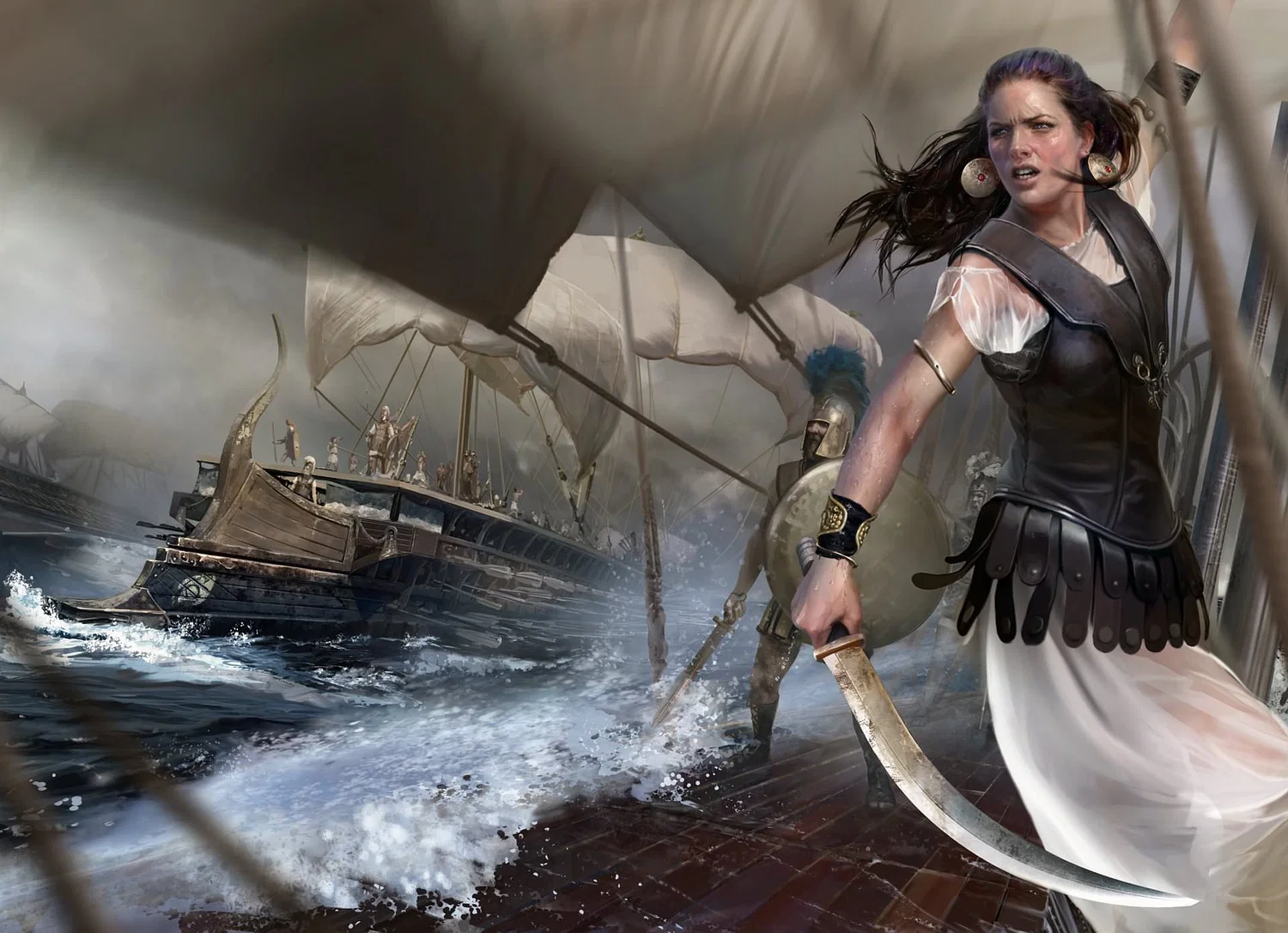
Teuta, Queen of the Illyrian Ardiaei tribe, leads a pirate expedition against rome. – image from WorldHistory.org
The focus of the story is on the humans. Sure, there is a major magical supporting character, and some of the humans dabble in dark arts. But they remain people. That said, there is plenty of magic in the air, and water. Some creatures introduced in the Daevabad trilogy put in appearances here. There is a kaiju-level sea beast, and plenty more. I hesitate to say this, but it seemed at one point that more was less, and that there were maybe too many such roaming and flitting about.
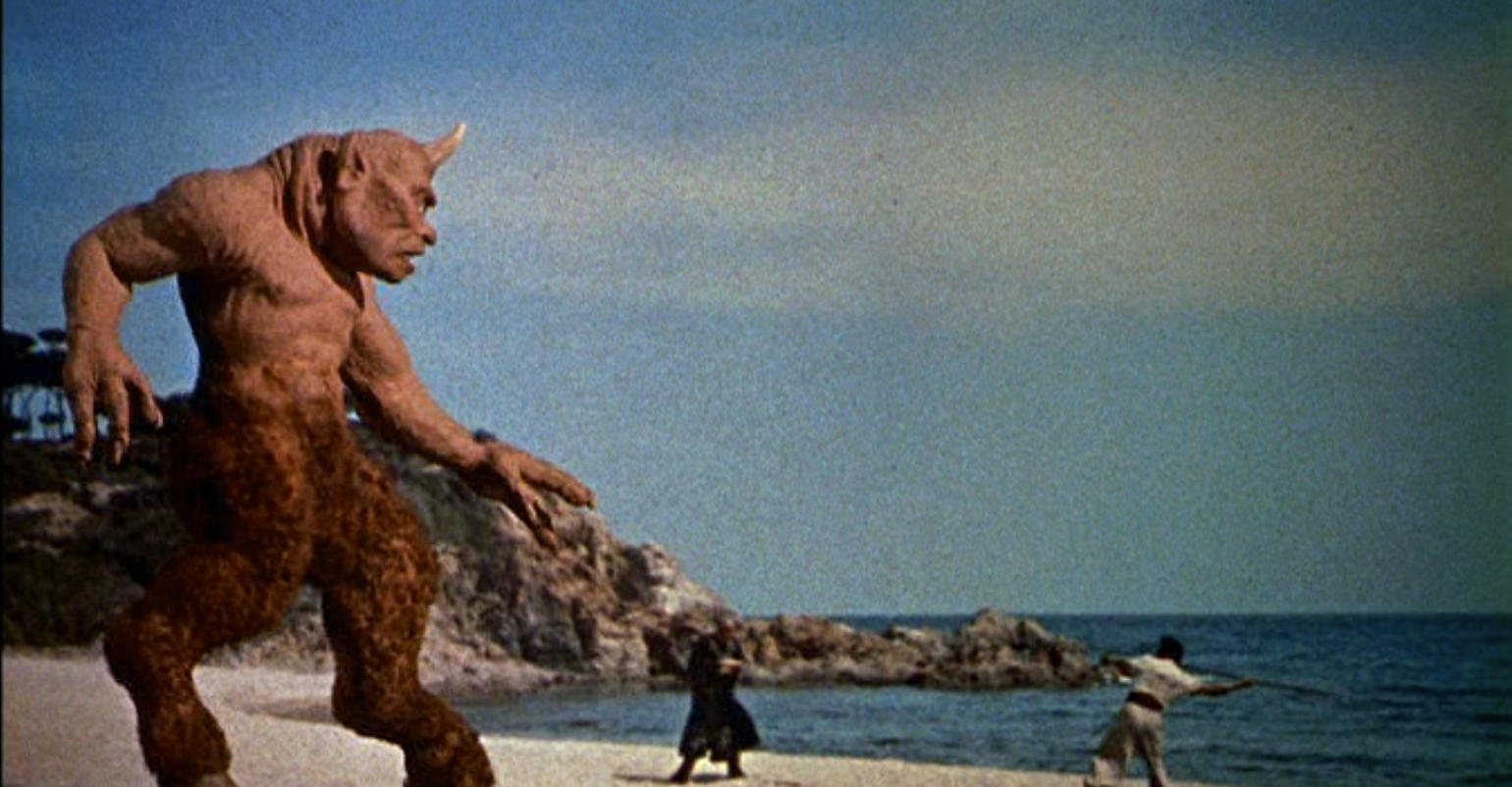
(I can only imagine what Ray Harryhausen would do with such a rich trove of material. Above is a still from The 7th Voyage of Sindbad
There is treasure. There is an island, and there is even a possible reference to Treasure Island, although, really, it may just be me projecting, and islands and treasure are merely standard tropes for the genre.
I straightened up with care, pinching my brow to keep black spots from dancing before my eyes.
Per usual, Chakraborty brings her effervescent sense of humor to her writing. There are plenty of LOL moments, particularly when Amina interacts with Dalila or Raksh.
“What about you, Lady Dalila?” Noor asked. “Is there anyone back home you are eager to return to?” Dalila picked at her teeth. “I had to abandon a time sensitive experiment with extremely promising indications as a knock-out gas.” “For pain relief,” I amended quickly. “Dalila is our…healer.” Noor’s brows rose slightly. “Ah, yes. Majed speaks frequently of how you ‘healed’ him when you first met.” Dalila rolled her eyes. “It was hardly the worst of my poisons. There are some physicians who actually believe it beneficial to vomit blood every now and then. It balances the humors.”
In addition, because Chakraborty is a historian at heart, she has delivered to us a treasure of intel about the world of this time and place.
When I started working on Amina, the goal I had for myself, and I think I wrote this in the author’s note at the end, was that I wanted to make it completely historically accurate—outside of the plot. I did a ton of research. There’s been an incredible amount of new work done on the medieval Indian Ocean, but you’re still looking at 12th-century texts. It’s almost 1,000 years ago, and there is a great limit to what we know. – from The Portalist interview
The series is set a few centuries before Chakraborty’s Daevabad trilogy, but exists in the same general corner of the planet. Some nods are offered to that world, including a small part for a magical creature from the Djinn tales. And a bit of snark.
“Oh, those weren’t humans. Those were daevas.” “What in God’s name is a _daeva?_” He held up a hand. “You don’t want to know, trust me. More overdramatic creatures have never existed. And they’re not even the worst ones here. Everyone likes to complain about humans, but let me tell you…spend a couple centuries with the inhabitants of the unseen realms, and you’ll be aching to haunt a mortal latrine.”
There is a form of ecstasy that occurs in reading some books. Some are serious, (Serena pops to mind) others are more of the entertainment sort. I remember, as a kid, being rapt by some of the great classic adventures, by Robert Louis Stevenson, Jules Verne, and others. I was desperate to continue reading, despite the unwillingness of my eyes, and my mother reminding me, yet again, to turn the flashlight off under my covers. Well settled into middle age, the Harry Potter series offered the same sort of excitement. About six years ago, I was delighted to report that I felt that joy once more, at a grizzled time of life, on reading Shannon Chakraborty’s Daevabad trilogy, about djinns and sundry contemporary creatures and figures. While these books did nothing to iron out the wrinkles that brace my eyes, or straighten a spine that has strayed much too far from the standard shape, they did offer many hours of pure, innocent joy, the sort I experienced when my soul was more truly unstained. I am overjoyed to report that Chakraborty has worked her magic again. The Adventures of Amina el-Sirafi, the first in a promised trilogy, is a treat for the eyes and the imagination. Unlike Michael Corleone, I am eager to be pulled back in. You will be, too. No Shanghaiing required. Climb aboard, me hearties, and let’s set sail. The adventure has just begun.
I wanted to travel the world and sail every sea. I wanted to have adventures, to be a hero, to have my tales told in courtyards and street fairs where perhaps kids who’d grown up like me, with more imagination than means might be inspired to dream. Where women who were told there was only one sort of respectful life for them could listen to tales of another who’d broken away—and thrived when she’d done so.
Review posted – 4/14/23
Publication date – 2/28/23
I received an ARE of The Adventures of Amina al-Sirafi from Harper Voyager (well, my book goddess secured this particular treasure for me) in return for a fair review. Thanks, dear, and thanks HV.
This review has been cross-posted on GoodReads
=======================================EXTRA STUFF
Links to the author’s personal, Twitter and FB pages
My reviews of other books by the author
—–2017 – The City of Brass (The Daevabad Trilogy #1)
—–2019 – The Kingdom of Copper (The Daevabad Trilogy #2)
—–2020 – The Empire of Gold (The Daevabad Trilogy #3)
Interviews
—–Lit Reactor – Shannon Chakraborty: Navigating the Creative Voyage by Jena Brown
—–The Portalist – Shannon Chakraborty Breaks Down Her Writing Process and New Book, The Adventures of Amina al-Sirafi by Jena Brown
—–Bookpage – Shannon Chakraborty sets sail for a new horizon by Linda M. Castellitto
—–The Fantasy Hive – INTERVIEW WITH SHANNON CHAKRABORTY (THE ADVENTURES OF AMINA AL-SIRAFI)
—–Writer’s Digest – Shannon Chakraborty: On Humor and Joy in Fantasy by Robert Lee Brewer
Items of Interest from the author
—–Fantasy Hive – Excerpt – Chapter 1
—–Tor – Excerpt – Chapter 5
Items of Interest
—–Americanliterature.com – Arabian Nights – The Story of Sindbad the Sailor
—– Godfather III – Just when I thought I was out, they pull me back in!
—–World History.Org – Queen Teuta of Illyria
April 9, 2022 · 12:01 am
The King’s Shadow by Edmund Richardson

As he left Agra behind, Lewis had no way of knowing that he was walking into one of history’s most incredible stories. He would beg by the roadside and take tea with kings. He would travel with holy men and become the master of a hundred disguises. He would see things no westerner had ever seen before, and few have glimpsed since. And, little by little, he would transform himself from an ordinary soldier into one of the greatest archaeologists of the age. He would devote his life to a quest for Alexander the Great.
There’s an old Afghan proverb: ‘First comes one Englishman as a traveller; then come two and make a map; then comes an army and takes the country. Therefore it is better to kill the first Englishman.’ He did not know it yet, but Masson is the reason that proverb exists. He was the first Englishman.
You have probably never heard of Charles Masson. At the time of his creation in 1827, no one else had either. Nor had his creator. For six long years, Private James Lewis had endured soldiering in the military force of the East India Company (EIC) in sundry nations and city-states, in what is now India, Pakistan, and Afghanistan. He had hoped for a life better than what was possible in a squalid London. Dire economic times had driven large numbers of people into bankruptcy and poverty. And if they were already poor, it drove them to desperation. The government’s response was to threaten to kill those protesting because of their inability to pay their debts. There had to be a better option somewhere, anywhere. But it had turned out not to be the better life that he had hoped for.

_Edmund Richardson_– image from RNZ
Lewis suffered from the multiple curses of curiosity and intelligence. He had tired of the often corrupt, ignorant, mean-spirited officers and officials above him, and knew he would not be allowed to leave any time soon. When opportunity presented, Lewis and another disgruntled employee took off, went AWOL, strangers in a strange land. And in the sands of the Indian subcontinent, having fled across a vast no man’s land, feverish, desperate, and terrified of being apprehended by the EIC or its agents, Lewis happened across an American, Josiah Harlan, leading a small mercenary force in support of restoring the king of Afghanistan, and the adventure begins. Lewis vanished into the sands and Charles Masson was born into Lewis’s skin.
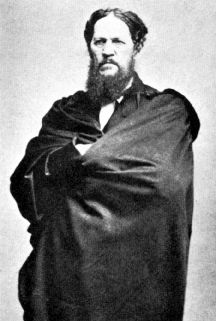
Josiah Harlan, The Man Who Would be King – image from Wiki
A ripping yarn, The King’s Shadow (Alexandria: The Quest for the Lost City in the UK) tells of the peregrinations and travails of Lewis/Masson from the time of his desertion in 1827 to his death in 1853. It will remind you of Rudyard Kipling tales, particularly The Man who Would Be King. The real life characters on whom that story is based appear in these pages.

Dost Mohammad Khan. – considered a wise ruler by many, he was devilishly dishonest – image from Genealogy Adventures Live
It certainly sounds as if the world James Lewis thought he was leaving in London, a fetid swamp of human corruption, cruelty, and depravity, had followed him to the East. There is an impressive quantity of backstabbing going on. Richardson presents us with a sub-continental panorama of rogues. Con-men, narcissists, spies, the power-hungry, the deluded, the pompous, the vain, the ignorant, and the bigoted all set up tents here, and all tried to get the best of each other. There are political leaders who show us a bit of wisdom. More who know nothing of leadership except the perks. They all traipse across a land that Alexander the Great had travelled centuries before.
His quest would take him across snow-covered mountains, into hidden chambers filled with jewels, and to a lost city buried beneath the plains of Afghanistan. He would unearth priceless treasures and witness unspeakable atrocities. He would unravel a language which had been forgotten for over a thousand years. He would be blackmailed and hunted by the most powerful empire on earth. He would be imprisoned for treason and offered his own kingdom. He would change the world – and the world would destroy him.
The American mercenary with whom Lewis/Masson joined forces was a fanatic about Alexander, seeing himself as a modern day version. He taught Masson about his idol and in time Masson took the obsession on as his own, albeit without the desire for a throne that drove his American pal, reading up on histories of Alexander.

Shah Shujah-al-Moolk, circa 1835 – the restored king of Afghanistan who served as a British puppet) – image from Genealogy Adventures Live
You will learn a bit about Alexander, of whom stories are still told. He may not seem so great once you learn of his atrocities. The British government and the East India company tried to keep up, demonstrating a capacity for grandiosity, cruelty and inhumanity, whilst also armed with alarming volumes of incompetence and unmerited venality

Alexander Burnes – image from Wiki
In his travels, aka invasions, conquests, and or large-scale slaughter, Alexander established a pearl necklace of cities along his route. Some were grander than others. One, in Egypt, is still a thriving metropolis. Most vanished beneath the drifts of time, whether they had been cities, towns, villages, or mere outposts. But Charles Masson was convinced that one of Alexander’s cities could be found the general area in which he was living. The evidence on which he based this view was cultural, appearing in stories, legends, and local lore, but then more concrete evidence began to appear (coins) and appear, and appear.
Time and again, Masson is dragged away from his work, and time and again he finds his way back, his passion for unearthing the lost Alexandria becoming the driving force in his life. Surely, if his own survival were his highest priority, he would have sailed for home a long, long time before he finally did. His work was hugely successful, all the more remarkable because he was a rank amateur. Much of Lewis’s work, thousands of objects and drawings, is still on display at the British Museum. He was a gifted archaeologist, and made several world-class advances. These include discovering a long-lost Alexandrian city and using ancient coins he had discovered, that contained Greek on one side, and an unknown language on the other, to decipher that language. And significantly modify the historical view of Alexander’s era.

Ranjit Singh, maharajah of the Punjab – image from Genealogy Adventures Live
The King’s Shadow is an adventure-tale biography, which focuses on Masson’s life and experiences more than on Alexander. Sure, there is enough in the book to justify the UK title, but barely. There is a lot more in here about him trying to secure the connection between his head and his shoulders, threatened by a seemingly ceaseless flood of enemies. He is a remarkably interesting character, which is what holds our interest. He has dealings with a large cast of likewise remarkably interesting characters, all of which serves to keep us interested, while passing something along about what life in this part of the world was like in the early 19th century. (Remarkably like it is today in many respects)
There are few downsides here. One is that there is a sizeable cast, so it might be a bit tough keep track of who’s who. That said, I was reading an ARE, so there might be a roster offered in the final version. I keep lists of names when I read, so managed, but that it seemed needed should prepare you for that. Second was that there were times when events went from A to D without necessarily explaining the B and C parts. For example, there is an episode in which Masson is sent along with a subordinate of Dost Mohammad Khan’s, Haji Khan, to extract taxes from a recalcitrant community. But Haji has no intention of returning, yet somehow Masson is back in Kabul in the following chapter. Really, did he escape? Did he get permission to leave? How did the move from place A to place B take place? In another, a military attack fails, yet there is no mention of why the fleeing army was not pursued. Things like that.
There are multiple LOL moments to be enjoyed. Not saying that there is any chance of passing this off as a comedy book, but Richardson’s sense of humor is very much appreciated. You may or may not find the same things amusing. His descriptions are sometimes pure delight. An itinerant Christian preacher arrives at the palace of Dost Mohammad Khan, intent on converting him. The preacher had encountered serial misfortunes in his travels and had arrived in Kabul stark naked. Richardson refers to him at one point as “the well ventilated Mr Wolff.” He also describes Masson arriving late at night at the home of Rajit Singh, the local maharaja, only to find an American in attendance, singing Yankee Doodle Dandy. Another tells of a message Masson left for future explorers at what was then an incredibly remote site. LOL time. As much as you will frown at the miseries depicted in these pages, you will smile, maybe even laugh, a fair number of times as well. I noted five LOLs in my notes. There are more than that.
Charles Masson, despite the lack of appreciation and recognition he received, made major contributions to our knowledge of the Alexandrian era. Edmund Richardson fills us in on those, while also offering a biography that reads like an Indiana Jones adventure. Richardson has a novelist’s talent for story-telling. His tale shows not only the power of singlemindedness and passion, but the dark side of far too many men, and some unfortunate forms of governance. It is both entertaining and richly informative. Bottom line is that The King’s Shadow darkens nothing while illuminating much. Jolly Good!
This is a story about following your dreams to the ends of the earth – and what happens when you get there. Had he known what was coming, Lewis might have stayed in bed.
Review posted – April 8, 2022
Publication date – April 5, 2022
I received an ARE of The King’s Shadow from St. Martin’s Press in return for a fair review and a couple of those very special coins. Thanks, folks. And thanks to NetGalley for facilitating.
This review has been cross-posted on GoodReads
=======================================EXTRA STUFF
From Hazlitt
Edmund Richardson writes about the strangest sides of history. The Victorian con-artist who discovered a lost city. The child prodigy turned opium addict. Several homicidal headmasters. A clutch of Spiritualists. A prophet who couldn’t get the end of the world right. And Alexander the Great. He’s currently Lecturer in Classics at Durham University. Cambridge University Press recently published his first book, Classical Victorians: Scholars, Scoundrels and Generals in Pursuit of the Ancient World.
The King’s Shadow is Richardson’s third book.
Interviews
—–Travels Through Time – Interview with Edmund Richardson on Charles Masson and the search for Alexandria with Violet Mueller – re prior book
Tttpodcast.com
—–Travels Through Time – Interview with Edmund Richardson on Charles Masson and the search for Alexandria – audio – 48:03
—–Listen Notes – Edmund Richardson, “Alexandria: The Quest for the Lost City Beneath the Mountains” (Bloomsbury, 2021) – with David Chaffetz and Nicholas Gordon – audio – 36:14
—– Alexandria: The Quest for the Lost City | JLF London 2021 – Edmund Richardson with Taran N. Khan – video – 45:32 – begin about 3:00
—–ABC – Deserter, archaeologist and spy – the extraordinary adventures of Charles Masson – audio – 55:28 – with Sarah Kanowski
Item of Interest from the author
—–A pawn in the Great Game: the sad story of Charles Masson
Items of Interest
—–Wiki on Charles Masson
—–Encyclopedia Iranica – Charles Masson – a nice history of his life and accomplishments
—–Josiah Harlan
—–Alexander Burnes
—–Gutenberg – The Man Who Would Be King by Rudyard Kipling – full text
—–Wiki on the story – The Man Who Would Be King
Filed under Afghanistan, Archaeology, Bio/Autobio/Memoir, England, History, Reviews, World History
Tagged as Adventure, Archaeology, biography, history, Nonfiction, World History

